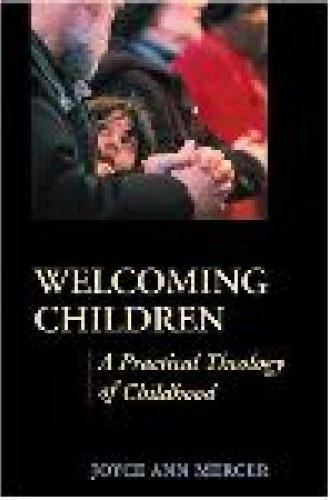Welcoming Children
I must admit that I am drawn to books with the word children in the title. Actually I approach these titles with both interest and suspicion. Two questions guide my evaluation. First, which genre does this book represent? Is it a how-to book for children’s ministry or a reflective work that will generate new thinking about the foundation and practice of ministry with children? The second question helps me to determine how my own thinking will be disturbed by the book: What sources have contributed to the shape and form of the author’s argument?
Welcoming Children is the latest in a growing body of literature on children, faith, families and congregations. Writing from her perspective as a practical feminist theologian, Joyce Ann Mercer aimed to start small in this volume, but the task she set before herself is enormous:
In a consumerist society, the wider culture lifts up a dominant vision of children, namely children as consumers. Christian theology can offer an alternative vision of the meaning of childhood. This vision will provide alternative practices that compose a way of life for children and for adults who accompany them. Together they must seek to walk in the way of Jesus, a way opposed to the hostile and inhospitable visions so prevalent in North America today.
Ambivalence is the stumbling block standing in the way of those who welcome, nurture and support children in today’s culture, Mercer argues. From a study of liberating advocacy for children in selected Gospel passages, she moves to an examination of the ways children are understood and the way they are treated in this culture from a consumer and religious perspective. Her questions are not new to parents, but her weighty critique of the market empire, the religious right and churches that separate children from the worship life and ministry of the congregation provides a wide lens for examining the role of children in the postmodern world.
Mercer believes that churches have an essential role in mediating between children and the consumer forces that target and abuse them. Her sources in theology (Barth, Brock, Miller-McLemore), economic theory and global capitalism (Harvey, Bourdieu) and education (Vygotsky, Friere) create a diverse group of conversation partners for the development of a feminist practical theology of childhood.
This is not a simple how-to book on ministry with children. The emerging questions will both disturb and startle those who hold complacent attitudes about children in the culture and in the church, and whose practices reflect that complacency.
• How are children shaped by consumer culture and religious culture, and in what ways do these two cultures harm children?
• How do parents raise children in such a way that children believe more is better by the time they are three years old?
• Do we view children as innocents or as sinful creatures? How is our theology of children made explicit in our congregations’ models of Christian education?
• How can children be apprenticed in the practices of the Christian faith if they are marginalized in a “separate children’s ecclesial culture”?
• What needs to be changed in our practices in order that all children may flourish?
This book is important both for parishioners who are intimately involved in the lives of children and for those who see children only at a distance. Mercer’s extensive use of sources necessitates a deliberative reading style and may make the book inaccessible to those who seek a quick fix for their congregations’ ministry with children and families. Yet the hard thinking about ambivalence is essential to Mercer’s argument for an emancipatory theology of childhood in which children have a dual function: being a sign of hope in our culture and providing a way for all of us to welcome God.
Mercer acknowledges that children may not be able to sit still in worship, that they may be happy, sad or sick, are not always clean and cooperative. And she reminds us that these are the ones whom “Jesus calls, blesses, welcomes, and gives over to our care.” Our theology is incomplete without a struggle to address the practical ways we welcome children into our lives and congregations.






